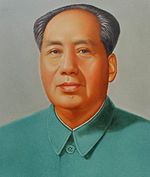- Communist (Maoist) Party of Afghanistan
-
Communist (Maoist) Party of Afghanistan
حزب كمونيست (مائوئيست) افغانستانFounded 2004 Headquarters None (Illegal Organisation) Ideology Communism,
Anti-Revisionist
Marxism-Leninism,
MaoismInternational affiliation Revolutionary Internationalist Movement Website Official website Politics of Afghanistan
Political parties
ElectionsThe Communist (Maoist) Party of Afghanistan (Persian: حزب كمونيست (مائوئيست) افغانستان, Hezb-e Komunist (Ma'uist) Afghanistan) previously known as Communist Party of Afghanistan is an underground political party in Afghanistan. The party is the continuation of the line started by the Revolutionary Internationalist Movement.
The Communist (Maoist) Party of Afghanistan is an underground organization, with the stated goal of starting a "people's national war of resistance against the occupying forces and the United States of America", establishing a New democratic society, and establishing socialism in Afghanistan.[1]
History
The first communist organization in Afghanistan, Progressive Youth Organization (PYO) was formed in 1965. There were daily demonstrations, and street fighting between students, workers, and social justice activists and police and armed forces of King Zaher Shah of Afghanistan. These struggles led to the formation of Progressive Youth Organization. A few circles of intellectuals and political activists came together to form the first communist organization to work for the goal of revolution in Afghanistan. Akram Yari, a Maoist, was the leader of one these circles, who played a prominent role in the formation of PYO.[2]
PYO remained an underground organization. The PYO leaders published a magazine called Sholaye Jawid. Sholaye Jawid claimed to be a new-democratic journal, which was widely and openly circulated. After publishing 11 issues, Sholaye Jawid was seized by government and its publication banned. The government of the time used law enforcement and Islamic fundamentalists against Sholaye Jawid supporters. These government tactics led to physical confrontation between those who supported the Maoists and those who were against the Maoists, that resulted to the death of a prominent Maoist student leader Saydal Sokhandan, who was assassinated by Gulbadin Hekmatyar on the Kabul University campus. Gulbadin Hekmatyar later became the leader of the Islamic Party of Afghanistan, who has been a key ally of the United States in the past.[citation needed]
Part of the Politics series on Maoism  Prominent MaoistsParties by countryAfghanistan · Argentina ·
Prominent MaoistsParties by countryAfghanistan · Argentina ·
Bangladesh · Bolivia
Bhutan · Canada ·
Colombia · Ecuador ·
India · Iran ·
Italy · Japan ·
Nepal · Norway · Peru ·
Philippines · Portugal ·
Sri Lanka · Turkey ·
United StatesRelated topics Communism Portal
Communism Portal
Politics portalWhen the People's Democratic Party of Afghanistan (PDPA) came to power in a military coup in 1978, the PDPA regime declared their number one enemy to be the PYO led Maoist movement.[citation needed] All people belonging to the Maoist movement were arrested and killed indiscriminately. Thousands of Maoists and their allies were killed. The leaderless remnants of the Maoist movement formed several organizations to fight the PDPA regime and resist the Soviet invasion of Afghanistan. During this period, some communist groups became more closely aligned with Islamic mujahideen groups of a type they had previously opposed.
The hardline Maoist organisations detached themselves from those who cooperated with the mujahideen, and in the late 1980s these groups formed the Revolutionary Communist Cell of Afghanistan. The RCCA along with others formed the Revolutionary Communist Organization of Afghanistan, which in 1991 proclaimed the establishment of the Communist Party of Afghanistan. The CPA renewed publication of Sholaye Jawid, stating their intent to follow in the footsteps of the PYO and its founder Akram Yari.
Following the 2001 invasion of Afghanistan, the CPA called on the Maoist organizations to unite in a single, united Maoist party. For that purpose the CPA with four other Maoist organizations formed the Unity Committee of Marxist-Leninist-Maoist Movement of Afghanistan. The Unity Committee after three years of ideological and political struggle went for the Unity Congress of the Communist (MLM) Movement. The Unity Congress was concluded on May 1, 2004 and the Communist (Maoist) Party of Afghanistan was formed.
External links
References
Political parties in Afghanistan 
Present major parties United National Front · Afghan Mellat · New Afghanistan Party · Junbish-e Islami (National Islamic Movement of Afghanistan) · Jamiat-e Islami · Hezbe Wahdat · Hezbi Islami · Ittehad-I IslamiPresent minor parties Banned / Former parties People's Democratic Party of Afghanistan · Taliban · Communist (Maoist) Party of Afghanistan · Democratic Watan Party of Afghanistan · Afghanistan Liberation Organization · National Revolutionary Party of AfghanistanPortal:Politics · List of political parties · Politics of Afghanistan Categories:- Political parties in Afghanistan
- Communist parties in Afghanistan
- Banned communist parties
- Maoist organizations
- Clandestine groups
- Political parties established in 2004
Wikimedia Foundation. 2010.
